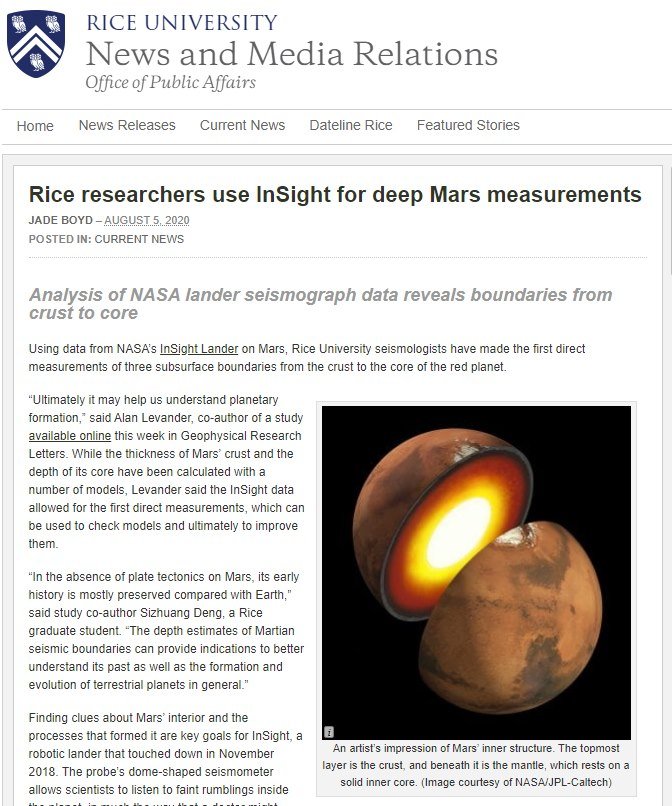
Using data from NASA’s InSight lander, seismologists at Rice University on Mars have made the first direct measurements of the three subsurface boundaries, from the crust to the core of the red planet.
“Ultimately, it could help us understand planetary formation,” said Alan Levander, co-author of a study available online this week in Geophysical Research Letters. While the thickness of Mars’ crust and the depth of its core have been calculated using a variety of models, Levander said the InSight data allowed the first direct measurements, which can be used to check the models and ultimately improve them.
“In the absence of plate tectonics on Mars, its early history is mostly preserved compared to Earth,” said study co-author Sizhuang Deng, a graduate student at Rice University. “Depth estimates of Martian seismic boundaries may provide insights to better understand its past as well as the formation and evolution of terrestrial planets in general.”
Finding clues about Mars’ interior and the processes that formed it are key goals for InSight, the lander that landed in November 2018. The probe’s domed seismometer allows scientists to listen for faint rumblings inside the planet, in a way very similar to a doctor listening to a patient’s heartbeat with a stethoscope.
Seismometers measure the vibrations of seismic waves. Like the circular ripples that mark the point where a pebble has disturbed the surface of a pond, seismic waves flow through planets, marking the location and size of disturbances such as meteor impacts or earthquakes, which are aptly named martemots on the red planet. InSight’s seismometer recorded more than 170 such events from February through September 2019.
Seismic waves are also slightly altered as they pass through different types of rock. Seismologists have studied patterns in seismographic recordings on Earth for more than a century and can use them to map the location of oil and gas deposits and much deeper layers.
“The traditional way to investigate structures beneath Earth is to analyze earthquake signals using dense networks of seismic stations,” Deng said. “Mars is much less tectonically active, which means it will have far fewer seismic events than Earth. Also, with only one seismic station on Mars, we cannot use methods that normally rely on seismic survey networks.”
Levander and Deng analyzed InSight’s 2019 seismological data using a technique called ambient noise autocorrelation. “It uses continuous noise data recorded by the single seismic station on Mars to extract reflection signals from seismic boundaries,” Deng said.
The first boundary measured by Deng and Levander is the division between Mars’ crust and mantle nearly 35 kilometers below the lander.
The second is a transition zone within the mantle where magnesium and iron silicates undergo a geochemical change. Above the zone the elements form a mineral called olivine and below it heat and pressure compress them into a new mineral called wadsleyite. Known as the olivine-wadsleyite transition, this zone was found 1,110-1,170 kilometers below InSight.
“The temperature at the olivine-wadsleyite transition is an important key to building thermal models of Mars,” Deng said. “From the depth of the transition, we can easily calculate the pressure, and with that, we can derive the temperature.”
The third boundary he and Levander measured is the boundary between Mars’ mantle and its iron-rich core, which they found about 1,520 to 1,600 kilometers below the lander. A better understanding of this boundary “may provide information about the planet’s development from both chemical and thermal perspectives,” Deng said.
Free translation of article, “Rice researchers use InSight for deep Mars measurements” http://news.rice.edu/2020/08/05/rice-researchers-use-insight-for-deep-mars-measurements-2/
Other reference article:
“NASA InSight gives us the first real peek at Mars’ interior structure” https://www.theweathernetwork.com/ca/news/article/nasa-insight-gives-us-first-real-peek-at-the-interior-structure-of-mars
This post has been automatically translated. See the original post here.